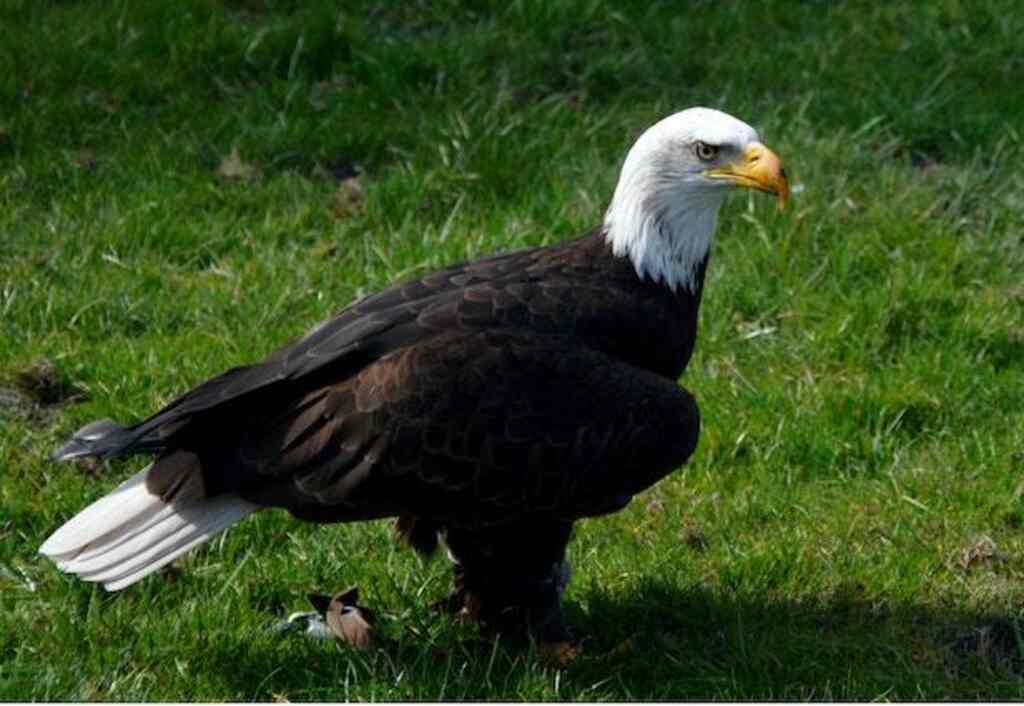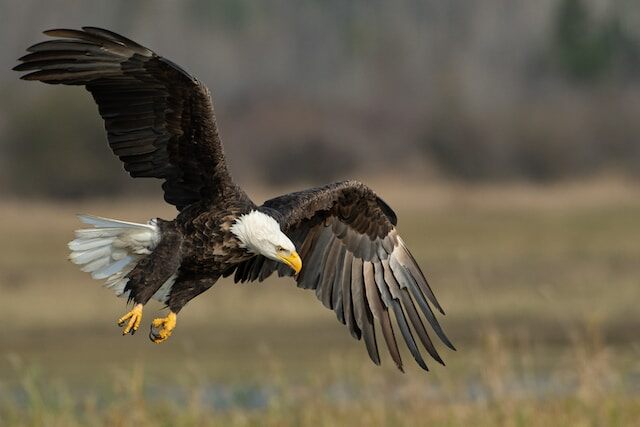While eagles are known for their carnivorous diet, there’s a lesser-known aspect of their eating habits that’s worth exploring: Do Eagles Eat Caterpillars?
Ornithologists and avian biologists are on a quest to unravel the mysteries surrounding eagles’ consumption of these larvae, shedding light on the nutritional value they offer and the factors that influence their consumption.
Join us as we examine the hunting techniques employed and the ecological implications of caterpillar consumption by eagles.
Table of Contents
- 1 Key Takeaways
- 2 Do Eagles Eat Caterpillars
- 3 An Introduction to Eagles’ Dietary Habits
- 4 The Diverse Diet of Eagles
- 5 Exploration of Caterpillars as Potential Prey for Eagles
- 6 Nutritional Value of Caterpillars for Eagles
- 7 Factors Influencing Eagle’s Consumption of Caterpillars
- 8 Observations and Studies on Eagle-Caterpillar Interactions
- 9 Potential Benefits and Drawbacks of Eating Caterpillars for Eagles
- 10 Other Insects in the Diet of Eagles
- 11 Eagle’s Hunting Techniques for Caterpillars
- 12 The Role of Caterpillars in Eagle’s Ecosystem
- 13 Conclusion: the Role of Caterpillars in Eagle’s Diet
- 14 Frequently Asked Questions
- 15 Author
Key Takeaways
- Eagles are generalist feeders and have been observed consuming caterpillars as part of their diverse diet.
- Caterpillars provide a significant portion of an eagle’s dietary protein and may contain beneficial compounds like antioxidants.
- Predation on caterpillars by eagles helps regulate their populations and prevent outbreaks that could damage vegetation.
- The role of caterpillars in the eagle’s diet is crucial for maintaining a healthy and balanced ecosystem.

Do Eagles Eat Caterpillars
Yes, eagles do eat caterpillars. While they are primarily known for their hunting skills in capturing larger prey, eagles also include caterpillars in their diet.
Caterpillars serve as a valuable food source, providing essential nutrients for the birds’ survival and growth.
An Introduction to Eagles’ Dietary Habits
Eagles’ dietary habits encompass a diverse range of prey, including but not limited to fish, small mammals, amphibians, and birds.
As raptors, eagles have developed specialized hunting techniques to capture and consume their prey. They use their sharp talons to seize and kill their targets, and their beaks to tear apart the flesh.
While caterpillars are not a primary food source for eagles, they may occasionally consume them as part of their diet.
However, the impact of caterpillar consumption on eagle population dynamics is not well understood.
Further exploration of this topic is needed to determine the nutritional value of caterpillars for eagles, and whether the consumption of larvae has any significant influence on the overall health and abundance of eagle populations.
Understanding the diverse diet of eagles is crucial in evaluating their ecological role and conserving their populations.
The Diverse Diet of Eagles
With their varied feeding habits, eagles demonstrate a wide range of dietary preferences and consume a diverse array of organisms.
Raptors, such as eagles, are known to have a generalist feeding strategy, meaning they consume various types of prey.
While they are primarily carnivorous, their diet can include a wide range of animals, including mammals, birds, reptiles, and fish.
However, insects, including caterpillars, also play a role in their diet. Although caterpillars may not be a significant source of nutrition for eagles, they can still contribute to their overall diet.
The nutritional value of caterpillars varies depending on the species, but they are generally rich in protein and fats.
While the impact of caterpillar consumption on eagle populations is not yet fully understood, further exploration of caterpillars as potential prey for eagles could provide valuable insights into their feeding habits and ecological role.

Exploration of Caterpillars as Potential Prey for Eagles
An investigation into the dietary habits of raptors could shed light on the potential ecological significance of including caterpillars as a food source.
Raptors, such as eagles, are known to be potential predators that have evolved various adaptations to capture and consume prey efficiently.
While eagles are commonly associated with hunting small mammals, birds, and fish, there is growing evidence that they also prey on caterpillars.
This has important implications for understanding the ecological role of eagles and their impact on caterpillar populations.
By including caterpillars in their diet, eagles may contribute to regulating caterpillar populations and influencing the dynamics of forest ecosystems.
Further research is needed to investigate the nutritional value of caterpillars for eagles and to determine the extent to which they rely on this food source.
Nutritional Value of Caterpillars for Eagles
One possible objection to the idea of caterpillars being a significant food source for eagles is that they may not provide sufficient nutrients to sustain the energy needs of these large raptors.
However, research has shown that caterpillars can indeed be a valuable component of an eagle’s diet.
Eagles are opportunistic predators and have been observed consuming a variety of prey, including caterpillars.
While the nutritional value of caterpillars may vary depending on species and stage of development, they are generally rich in protein and other essential nutrients.
In fact, some studies have suggested that caterpillars can provide a significant portion of an eagle’s dietary protein.
Additionally, the consumption of caterpillars may have positive effects on eagle health, as they can contain beneficial compounds such as antioxidants and antimicrobial agents.
Understanding the caterpillar prey preferences and the impact of caterpillar consumption on eagle health is essential for comprehending the factors influencing eagles’ consumption of caterpillars.
Factors Influencing Eagle’s Consumption of Caterpillars
Factors influencing the consumption of caterpillars by eagles extend beyond nutritional value, encompassing considerations such as prey availability, habitat suitability, and potential inter-species competition.
Eagles, being raptors, exhibit selective feeding behaviors based on the abundance and accessibility of their prey.
Caterpillars, also known as larvae, are an important food source for eagles due to their high protein content.
However, the consumption of caterpillars by eagles is influenced by various factors. Prey availability plays a crucial role, as eagles will consume caterpillars when they are abundant and easily obtainable.
Habitat suitability is another factor, as eagles prefer areas with dense vegetation where caterpillars are more likely to be found.
Additionally, interspecies competition may affect the consumption of caterpillars by eagles, as other bird species may also rely on them as a food source.
Further research is needed to fully understand the complex interactions between eagles and caterpillars.
Observations and studies on eagle-caterpillar interactions have shed light on the importance of these factors in determining the consumption patterns of eagles.

Observations and Studies on Eagle-Caterpillar Interactions
Observations and studies on eagle-caterpillar interactions have shed light on the extent to which eagles consume caterpillars and the potential impact on caterpillar populations.
Raptors, such as eagles, are known to engage in predation, which includes the consumption of various prey species, including larvae like caterpillars.
These interactions have been documented through field observations and scientific studies, providing valuable insights into the feeding behavior of eagles.
Through these studies, it has been observed that eagles do consume caterpillars, although the extent of their predation may vary depending on factors such as prey availability and nutritional value.
Furthermore, the consumption of caterpillars by eagles may have implications for caterpillar populations, potentially influencing their abundance and distribution in ecosystems.
Understanding the dynamics of eagle-caterpillar interactions is crucial in comprehending the ecological role of eagles and their impact on prey populations.
Transitioning into the subsequent section, it is important to explore the potential benefits and drawbacks of eating caterpillars for eagles.
Potential Benefits and Drawbacks of Eating Caterpillars for Eagles
The potential benefits and drawbacks of consuming caterpillars for eagles can be explored by examining the ecological implications of this dietary choice.
Caterpillars, also known as larvae, are a common food source for many raptors, including eagles. They provide a high nutritional value, rich in protein and essential nutrients.
Moreover, caterpillars are abundant and easily accessible, making them an attractive prey item for eagles. However, there are some potential drawbacks to relying heavily on caterpillars as a food source.
Firstly, caterpillars may contain toxins or chemicals from the plants they consume, which could have negative effects on eagle health and reproduction.
Additionally, a diet that is too heavily reliant on caterpillars may result in limited dietary diversity, potentially leading to nutritional deficiencies.
Therefore, while caterpillars can offer substantial benefits to eagles, it is important for these raptors to have a varied diet that includes other insects as well.
Transition: Moving beyond caterpillars, eagles also incorporate other insects into their diet.
Other Insects in the Diet of Eagles
In addition to caterpillars, other insects play a significant role in the diet of eagles. Eagles are skilled hunters and have a diverse prey selection, which includes various insects.
They are known to feed on beetles, grasshoppers, crickets, and other small arthropods. These insects provide a valuable source of nutrition for eagles, as they are rich in protein and other essential nutrients.
The ability of eagles to adapt their diet to different prey species is an adaptive trait that allows them to thrive in various habitats.
Insect hunting is a common behavior observed in raptors, and eagles employ different hunting techniques to capture their prey, including aerial pursuits and ground foraging.
Understanding the role of insects in the eagle diet contributes to our knowledge of their ecological niche and foraging strategies.
Transitioning into the subsequent section about the eagle’s hunting techniques for caterpillars, these birds employ specific hunting strategies to capture these larvae.
Eagle’s Hunting Techniques for Caterpillars
One interesting statistic reveals that eagles employ a variety of hunting techniques, such as swooping, hovering, and perching, to successfully capture caterpillars. These raptors exhibit remarkable precision and agility in their pursuit of these larvae.
Caterpillars, being a vital part of the eagle’s diet, offer several benefits.
Firstly, they provide a rich source of nutrients, including proteins, fats, and essential vitamins, which are crucial for the eagle’s growth and development.
Secondly, the act of predation on caterpillars helps regulate their populations, preventing outbreaks that could potentially damage vegetation.
Moreover, caterpillars are known to accumulate toxins from the plants they feed on, and eagles have developed mechanisms to tolerate or even detoxify these harmful compounds, thereby reducing the risk of poisoning.
Understanding the intricate eagle-caterpillar interactions and the benefits of eating caterpillars is essential for comprehending the broader role of caterpillars in the eagle’s ecosystem.

The Role of Caterpillars in Eagle’s Ecosystem
Caterpillars play a significant role in maintaining the delicate balance of the eagle’s ecosystem. These larvae are an important food source for raptors, including eagles, and their predation contributes to the overall ecological dynamics of the system.
Eagles, being opportunistic predators, have adapted their hunting techniques to include caterpillars as part of their diet.
Caterpillars provide a high nutritional value to eagles, as they are rich in proteins and fats.
The predation of caterpillars by eagles helps regulate caterpillar populations, preventing potential outbreaks and maintaining a stable ecosystem.
Additionally, the consumption of caterpillars by eagles may have indirect effects on other species within the ecosystem, such as influencing the abundance and distribution of plant species that rely on caterpillars for pollination.
In conclusion, the role of caterpillars in the eagle’s diet is crucial for maintaining a healthy and balanced ecosystem.
Conclusion: the Role of Caterpillars in Eagle’s Diet
The significant role of caterpillars in the eagle’s diet is crucial for maintaining a healthy and balanced ecosystem, as their predation helps regulate caterpillar populations and influences the abundance and distribution of other species within the ecosystem.
Eagles, as raptors, rely on a diverse diet to meet their nutritional needs, and caterpillars provide a valuable food source due to their high protein content and abundance.
Studies have shown that caterpillar consumption can have a direct impact on eagle population dynamics, as it affects their reproductive success and overall fitness.
Additionally, the consumption of caterpillars by eagles helps to control the population of these larvae, preventing outbreaks that could potentially damage vegetation and disrupt the delicate balance of the ecosystem.
Therefore, understanding the importance of caterpillars in the eagle’s diet is essential for conservation efforts and the preservation of healthy ecosystems.
| Importance of Caterpillars in Eagle’s Diet | Impact of Caterpillar Consumption on Eagle Population Dynamics |
|---|---|
| Regulates caterpillar populations | Affects reproductive success and overall fitness |
| Influences abundance and distribution | Controls potential outbreaks and preserves healthy ecosystems |

Frequently Asked Questions
How do eagles hunt for caterpillars?
Eagles hunt for caterpillars by using various techniques such as visual scanning, aerial pursuit, and ambush. The interaction between eagles and caterpillars involves predation, with eagles consuming larvae as a part of their diet.
What are some other insects that eagles consume?
Insect diversity plays a significant role in the diet of raptors, such as eagles. While caterpillars are a common prey item, eagles also consume other insects, including beetles, grasshoppers, and dragonflies. The impact of this insect diversity on eagle populations is still being studied.
Do caterpillars provide any nutritional benefits to eagles?
Caterpillar diet has a potential impact on eagle health. Caterpillars, as larvae, are consumed by raptors, contributing to their diet. However, more research is needed to determine the specific nutritional benefits caterpillars provide to eagles and their overall impact on eagle populations.
What factors influence an eagle’s decision to consume caterpillars?
Factors influencing eagles’ decision to consume caterpillars include availability of alternative prey, nutritional benefits of caterpillar consumption, and energy expenditure required for predation. Understanding these factors aids in studying raptor foraging behavior.
Are there any potential drawbacks to eagles eating caterpillars?
Potential risks to eagles eating caterpillars include the presence of toxic compounds in certain species, such as alkaloids, which may impact the eagle’s diet and overall health. Raptors must carefully balance their consumption of larvae to avoid negative consequences.


